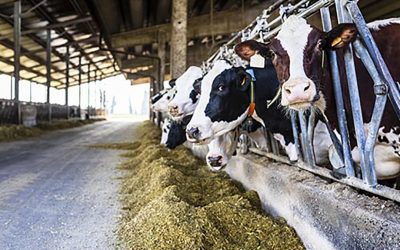Muscle deposition confirms efficacy of L-Selenomethionine

Se compounds can be distinguished on the basis of their bioavailability in the animal. Compounds that are highly bioavailable are able to be deposited efficiently in the muscle and increase the selenium status of animals to such an extent that, under challenging conditions, they are able to withstand the challenges brought forth by increased oxidation and free radicals.
Poultry that are not able to withstand oxidative stress will inevitably show negatively affected immunity, growth, feed efficiency, fertility, hatchability and egg production. The selenium source known for its high bioavailability is L-Selenomethionine (L-SeMet). It is the only selenium source that can be directly build into animal proteins. This is possible due to the fact that the protein production apparatus does not distinguish between L-methionine and L-SeMet. Because of this ‘ready-to-be-build-in’ ability, the compound L-SeMet is up to 100% bioavailable and shows therefore the highest efficacy. What about the efficacy of other selenium sources?
Selenium sources and their deposition in broiler muscle
The efficacy of 4 different selenium sources on the deposition of selenium in broiler muscle tissue were compared in an in vivo trial at KU Leuven, Faculty of Engineering Technology (Geel, Belgium). Results are presented in Figure 1.
In this trial male broilers were fed one of five treatment starter diets. All treatments had 4 pens with 5 animals per pen.
- Treatment 1 was supplemented with 0.2 mg/kg total Se from sodium selenite (SS).
- Treatment 2 and 3 were supplemented with L-SeMet (Excential Selenium4000, Orffa Additives BV, The Netherlands) at a dosing of 0.2 and 0.16 mg/kg total selenium, providing 0.2 mg/kg Se and 0.16 mg/kg Se in the form of L-SeMet respectively.
- Treatment 4 was supplemented with 0.2 mg/kg total Se in the form of hydroxy-selenomethionine (OH-SeMet), which provides respectively 0.0 mg/kg total Se in the form of L-SeMet to the diet.
- Treatment 5 was supplemented with 0.2 mg/kg total Se in the form of a Se-yeast, which resulted in a supplementation of 0.058 mg Se in the form of L-SeMet/kg (only 29% of the total Se was present in the form of L-SeMet; EU legislation requires a minimum of 63%).
In treatment 3 the dosage of 0.16 mg/kg Se in the form of L-SeMet was chosen, as it was hypothesised that the relative utilisation of OH-SeMet (treatment 4) should reach approximately 80% compared to L-SeMet.
Sample analysis
Representative samples of the left breast of 3 broilers per pen were taken on d14 and analysed for Se content by ICP-MS at the university of Ghent, Belgium. Results show a Se content in broiler muscle for treatment 1 (SS) of 93 µg/kg Se. The SeYeast showed 101 µg/kg Se. Treatment 2 and 3 (Exc. Selenium4000) showed the highest Se content in muscle with 263 µg/kg Se and 225 µg/kg Se, respectively. Treatment 4 showed a comparable Se content as treatment 3, OH-SeMet, and 16% lower than treatment 2, Exc. selenium4000 at 0.2 ppm Se. Exc.selenium4000 at 0.2 ppm se was the only compound able to maintain the selenium status observed at the start.
The observed lower efficacy (-16%) of OH-Se-Met compared to Exc. Selenium4000 confirms previous findings by Rovers et al. 2016 (abstract WPC). In this earlier trial, 3 different commercially available Se products were incorporated (Figure 2).
- Treatment 1 was supplemented with 0.2 mg/kg total Se from sodium selenite (SS).
- Treatment 2 was supplemented with L-SeMet (Excential Selenium4000, Orffa Additives BV, The Netherlands) at a dosing of 0.2 mg/kg total selenium.
- Treatment 3 was supplemented with 0.2 mg/kg total Se in the form of OH-SeMet. Representative samples of the breast were taken on d7 and analysed for Se content by ICP-MS at the university of Ghent, Belgium. Also here the OH-SeMet treatment showed a lower Se deposition then the Exc. Selenium4000 treatment. The difference in deposition was 15%.
Relative utilisation of L-methionine and its hydroxy analogue
EFSA (European Food Safety Authority) states that the relative utilisation of the hydroxy analogue of L-Met (OH-Met) is lower than L-Met. Table 1 gives an overview of the data brought forward by EFSA (ref 2012). Values are expressed as percentages of the growth efficacy (molar or isosulphurous basis) of the L-isomer, which is in all cases presumed to present 100% oral utilisation. The data shows that the relative utilisation of OH-Met for all tested animal species is lower than L-Met.
For pig and poultry this is down to 80%. The explanation for this observation lies among others in the conversion of OH-Met to L-Met inside the body. OH-Met is a DL racemic mixture consisting of an L isomer and a D isomer. After adsorption in the upper gastro intestinal tract by simple diffusion or through a low affinity lactic acid carrier mechanism, the conversion of DL-OH-Met takes place by enzymatic conversions.
The L isomer of OH-Met will be converted to a keto-methionine intermediate called keto-methylthio-butanoic acid (KMB) by L-hydroxy acid oxidase (L-HAOX) in peroxisomes found primarily in liver and kidney cells. The D isomer of OH-Met is converted to KMB as well but via D-hydroxy acid dehydrogenase (D-HADH) present in mitochondria of all cells. Eventually, KMB undergoes transamination to form L-Met. This complicated 2-way/2-step conversion is likely to be the cause of the lower relative utilisation. L-Met, by contrast, is simply built into proteins as such, no conversion is needed.
Conclusion
These studies show that the amount of deposited Se in muscle largely depends on the specific Se compound. OH-SeMet shows a lower efficacy then Exc. Selenium4000 due to the complicated conversion to L-SeMet it has to undergo before it can be incorporated in the proteins. In literature (EFSA Journal 2012;10(3):2623), the relative utilisation of OH-Met, compared to L-Met, for chicken is listed at 80%.
Studies performed by Orffa in collaboration with universities of Ghent and Leuven in Belgium confirm that this lower utilisation also applies for their selenium containing versions (OH-SeMet vs L-SeMet = 80% vs 100%) in 2 successive trials. Exc. Selenium4000 remains the only source that obtains the highest Se deposition and maintains the Se status of the broilers at start. A high Se deposition is necessary to withstand the challenges brought forth by an increased oxidation status. All animals will, at some time in their life, encounter increased oxidative stress. Only the highest bioavailable source enables them to cope with it.
By Brecht Bruneel, Orffa Additives, The Netherlands






